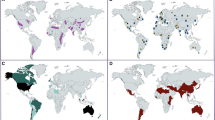Summary
1. In sea water at 25°C cells of Acetabularia crenulata exhibit a resting potential (RP) of-170 mV between cytoplasm and external medium. At temperatures below 10°C, or upon addition of 10-3m dinitrophenol in darkness, the cell shows a second steady potential (RP′) of about-70 mV. Among the cations of sea water, i.e. K+, Na+, Mg++, only K+ was found to affect RP and RP′. If the ionic strength of the medium is reduced by addition of isotonic mannitol solution, RP decreases, while RP′ is not influenced. RP′ is explained as a potassium diffusion potential, while for the existence of RP an electrogenic chloride pump is inferred which is driven by ATP of the photo- or oxidative phosphorylation (system X).-2. Starting from RP′, the current-voltage relationship consists of two linear portions for inward (R e ) and outward current (R a ), respectively, merging at RP′ (Fig. 3). Presumably they represent potassium conductances. For a given cell, the expression RT/F ln R e /R a yields a value which fits the RP′ of the cell (Fig. 20).-3. Starting from RP, a N-shaped current-voltage relationship was obtained for depolarisation (Fig. 3). The deviation from the potassium conductance is supposed to be due to the shunt of the potassium channel and the system X (voltage-dependent resistance). An electric circuit diagram was derived from voltage and current clamp experiments (Fig. 21); the elements of the circuit were tentatively analogized with cell functions.-4. Action potentials of about 120 mV, lasting from 30 to 300 sec may arise spontaneously. They can be triggered by lowering the temperature or depolarisation (voltage clamp, current clamp, light-off-cf. Figs. 2,11). The mechanism of the action potential can be derived from the properties of the chloride pump. Action currents were recorded upon different depolarizing steps by voltage clamp to yield current-coltage curves at different times after stimulation (Fig. 13).-5. Pulses of white light shift the potential off RP′: light-on elicits a small depolarisation, light-off a large transient hyperpolarisation. The primary event of this response is a change of current (Fig. 19), the voltage change being its consequence. This result is interpreted on the basis of the circuit diagram.
Similar content being viewed by others
Abbreviations
- AP:
-
Aktionspotential
- RP:
-
stabiles Potential bei ca.-170 mV
- RP′:
-
stabiles Potential bei ca.-70 mV
Literatur
Bentrup, F. W.: Die Morphogenese pflanzlicher Zellen im elektrischen Feld. Z. Pflanzenphysiol. 59, 309–339 (1968).
Beth, K.: Experimentelle Untersuchungen über die Wirkung des Lichtes auf die Formbildung von kernhaltigen und kernlosen Acetabularia-Zellen. Z. Naturforsch. 8b, 334–342 (1953).
Briggs, G. E.: Membrane potential differences in Chara australis. Proc. roy. Soc. B 58, 573–577 (1962).
Goldman, D.: Axon behavior and the structure of its membrane. Ber. Bunsenges. Phys. Chem. 71, 799–807 (1967).
Gradmann, D., Bentrup, F. W.: Light-induced membrane potential changes and rectification in Acetabularia. Naturwisenschaften 57, 46–47 (1970).
Hämmerling, J.: Zur Lebensweise, Fortpflanzung und Entwicklung verschiedener Dasycladaceen. Arch. Protistenk. 97, 7–56 (1944).
Hope, A. B.: Effects of bicarbonate ions on electrical properties. Aust. J. biol. Sci. 18, 789–801 (1965).
Jeschke, W. D.: Die cyclische und die nichtcyclische Photophosphorylierung als Energiequellen der lichtabhängigen Chloridaufnahme bei Elodea. Planta (Berl.) 73, 161–174 (1967).
— Lichtabhängige Veränderungen des Membranpotentials bei Blattzellen von Elodea densa. Z. Pflanzenphysiol. 62, 158–172 (1970).
Kitasato, H.: The influence of H+ on the membrane potential and ion fluxes of Nitella. J. gen. Physiol. 52, 60–87 (1968).
Lew, V. L., Glynn, I. M., Ellory, J. C.: ATP-net synthesis by reversal of Na+ pump. Nature (Lond.) 225, 865–866 (1970).
MacRobbie, E. A. C.: The nature of coupling between light energy and active ion transport in Nitella translucens. Biochim. biophys. Acta (Amst.) 94, 64–73 (1965).
Mullins, L. J.: Efflux of chloride ions during action potential of Nitella. Nature (Lond.) 196, 986–987 (1962).
Nagai, R., Tazawa, M.: Changes in resting potential and ion absorption by light in a single plant cell. Plant a. Cell Physiol. 3, 323–339 (1962).
Saddler, H. D. W.: The ionic relations of Acetabularia mediterranea. J. exp. Bot. 21, 345–359 (1970).
Schilde, C.: Zur Wirkung des Lichtes auf das Ruhepotential der grünen Pflanzenzelle. Planta (Berl.) 71, 184–188 (1966).
—: Schnelle photoelektrische Effekte der Alge Acetabularia. Z. Naturforsch. 23b, 1369–1376 (1968).
Slayman, C. L.: Electrical properties of Neurospora crassa. II. Respiration and the intracellular potential. J. gen. Physiol. 49, 93–116 (1965).
Author information
Authors and Affiliations
Additional information
Dissertation der Math.-Nat. Fakultät der Universität Tübingen.
Rights and permissions
About this article
Cite this article
Gradmann, D. Einfluß von Licht, Temperatur und Außenmedium auf das elektrische Verhalten von Acetabularia crenulata . Planta 93, 323–353 (1970). https://doi.org/10.1007/BF00384106
Received:
Issue Date:
DOI: https://doi.org/10.1007/BF00384106




